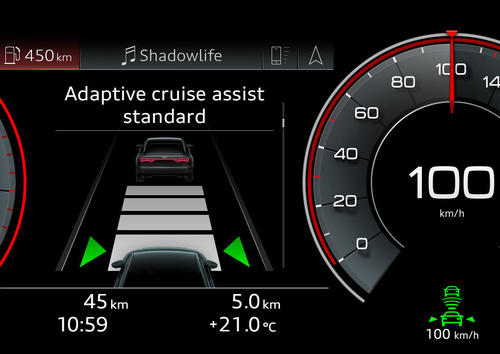Adaptive cruise control
Adaptive cruise control (ACC) maintains a set speed and following distance from the vehicle in front. It is designed to slow for cars ahead and can come to a full stop but may not react to already-stopped vehicles. ACC doesn’t react to traffic signals or other traffic controls.
The 2017 BMW 5-series with “Driving Assistant Plus,” 2017 Mercedes-Benz E-Class with “Drive Pilot,” 2018 Tesla Model 3 and 2016 Model S with “Autopilot” (software versions 8.1 and 7.1, respectively) and 2018 Volvo S90 with “Pilot Assist” were evaluated. All five have automatic emergency braking systems rated superior by IIHS.
Engineers evaluated ACC systems in four different series of track tests to see how they handle stopped lead vehicles and lead vehicles exiting the lane, and how the systems accelerate and decelerate.
One series involved driving at 31 mph toward a stationary vehicle target with ACC off and autobrake turned on to evaluate autobrake performance. Only the two Teslas hit the stationary target in this test.
The same test was repeated with ACC engaged and set to close, middle and far following distance in multiple runs.
With ACC active, the 5-series, E-Class, Model 3 and Model S braked earlier and gentler than with emergency braking and still avoided the target. The cars slowed with relatively gradual decelerations of 0.2-0.3 gs, braking in the same manner no matter the distance setting. Braking before impact was earlier for the Teslas than for the 5 series and E-Class.
The S90 braked more abruptly than the other models with ACC active, similar to its autobrake performance. In the ACC test, the S90 braked at a forceful 1.1g, just 1.1 seconds before impact to avoid the collision.
A third scenario involved following a lead vehicle that slows down to a stop and then accelerates. Every ACC system decelerated smoothly in this test.
A fourth scenario involved the test vehicle following a lead vehicle, which then changed lanes to reveal a stationary inflatable target vehicle in the path ahead when the time to collision was about 4.3 seconds.
None of the vehicles crashed into the target, and the 5 series, E-Class and Teslas all braked earlier and gentler than the S90, similar to the active ACC test.
Track tests are good for evaluating capability and performance in a controlled environment but not for assessing performance in traffic. Under ideal conditions, advanced driver assistance systems may function better than they do in more complex driving situations.
A case in point is the stopped-vehicle ACC tests. On the track, the 5 series, E-Class and Teslas braked to avoid the target vehicle. This was the case even though the owner’s manuals for all the test vehicles warn that ACC may not brake when it encounters vehicles that are already stopped when they come into sensor range.
Out on the road, engineers noted instances in which each vehicle except the Model 3 failed to respond to stopped vehicles ahead.
Jermakian recounts her experience with the E-Class on U.S. 33 near the IIHS-HLDI Vehicle Research Center (VRC). Traveling about 55 mph with ACC and active lane-keeping engaged but not following a lead vehicle, the E-Class system briefly detected a pickup truck stopped at a traffic light ahead but promptly lost sight of it and continued at speed until she hit the brakes.
“At IIHS we are coached to intervene without warning, but other drivers might not be as vigilant,” Jermakian says. “ACC systems require drivers to pay attention to what the vehicle is doing at all times and be ready to brake manually.”
Unnecessary or overly cautious braking is an issue IIHS noted in the Model 3. In 180 miles, the car unexpectedly slowed down 12 times, seven of which coincided with tree shadows on the road. The others were for oncoming vehicles in another lane or vehicles crossing the road far ahead.
“The braking events we observed didn’t create unsafe conditions because the decelerations were mild and short enough that the vehicle didn’t slow too much. However, unnecessary braking could pose crash risks in heavy traffic, especially if it’s more forceful,” Jermakian says.
“Plus, drivers who feel that their car brakes erratically may choose not to use adaptive cruise control and would miss out on any safety benefit from the system.”
The outlook is promising for the potential safety benefits of ACC. The technology is often bundled with forward collision warning and autobrake, and research by IIHS and HLDI has found crash-reduction benefits for these systems combined. A federally sponsored study found that drivers using ACC have longer, safer following distances than drivers who don’t use ACC. Still, IIHS tests indicate that current ACC systems aren’t ready to handle speed control in all traffic situations.
